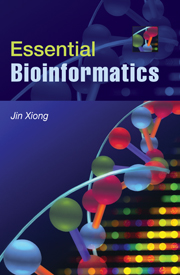Book contents
- Frontmatter
- Contents
- Preface
- SECTION I INTRODUCTION AND BIOLOGICAL DATABASES
- SECTION II SEQUENCE ALIGNMENT
- SECTION III GENE AND PROMOTER PREDICTION
- SECTION IV MOLECULAR PHYLOGENETICS
- SECTION V STRUCTURAL BIOINFORMATICS
- 12 Protein Structure Basics
- 13 Protein Structure Visualization, Comparison, and Classification
- 14 Protein Secondary Structure Prediction
- 15 Protein Tertiary Structure Prediction
- 16 RNA Structure Prediction
- SECTION V GENOMICS AND PROTEOMICS
- APPENDIX
- Index
- Plate section
- References
15 - Protein Tertiary Structure Prediction
Published online by Cambridge University Press: 05 June 2012
- Frontmatter
- Contents
- Preface
- SECTION I INTRODUCTION AND BIOLOGICAL DATABASES
- SECTION II SEQUENCE ALIGNMENT
- SECTION III GENE AND PROMOTER PREDICTION
- SECTION IV MOLECULAR PHYLOGENETICS
- SECTION V STRUCTURAL BIOINFORMATICS
- 12 Protein Structure Basics
- 13 Protein Structure Visualization, Comparison, and Classification
- 14 Protein Secondary Structure Prediction
- 15 Protein Tertiary Structure Prediction
- 16 RNA Structure Prediction
- SECTION V GENOMICS AND PROTEOMICS
- APPENDIX
- Index
- Plate section
- References
Summary
One of the most important scientific achievements of the twentieth century was the discovery of the DNA double helical structure by Watson and Crick in 1953. Strictly speaking, the work was the result of a three-dimensional modeling conducted partly based on data obtained from x-ray diffraction of DNA and partly based on chemical bonding information established in stereochemistry. It was clear at the time that the x-ray data obtained by their colleague Rosalind Franklin were not sufficient to resolve the DNA structure. Watson and Crick conducted one of the first-known ab initio modeling of a biological macromolecule, which has subsequently been proven to be essentially correct. Their work provided great insight into the mechanism of genetic inheritance and paved the way for a revolution in modern biology. The example demonstrates that structural prediction is a powerful tool to understand the functions of biological macromolecules at the atomic level.
We now know that the DNA structure, a double helix, is rather invariable regardless of sequence variations. Although there is little need today to determine or model DNA structures of varying sequences, there is still a real need to model protein structures individually. This is because protein structures vary depending on the sequences. Another reason is the much slower rate of structure determination by x-ray crystallography or NMR spectroscopy compared to gene sequence generation from genomic studies. Consequently, the gap between protein sequence information and protein structural information is increasing rapidly. Protein structure prediction aims to reduce this sequence–structure gap.
- Type
- Chapter
- Information
- Essential Bioinformatics , pp. 214 - 230Publisher: Cambridge University PressPrint publication year: 2006
References
- 2
- Cited by



